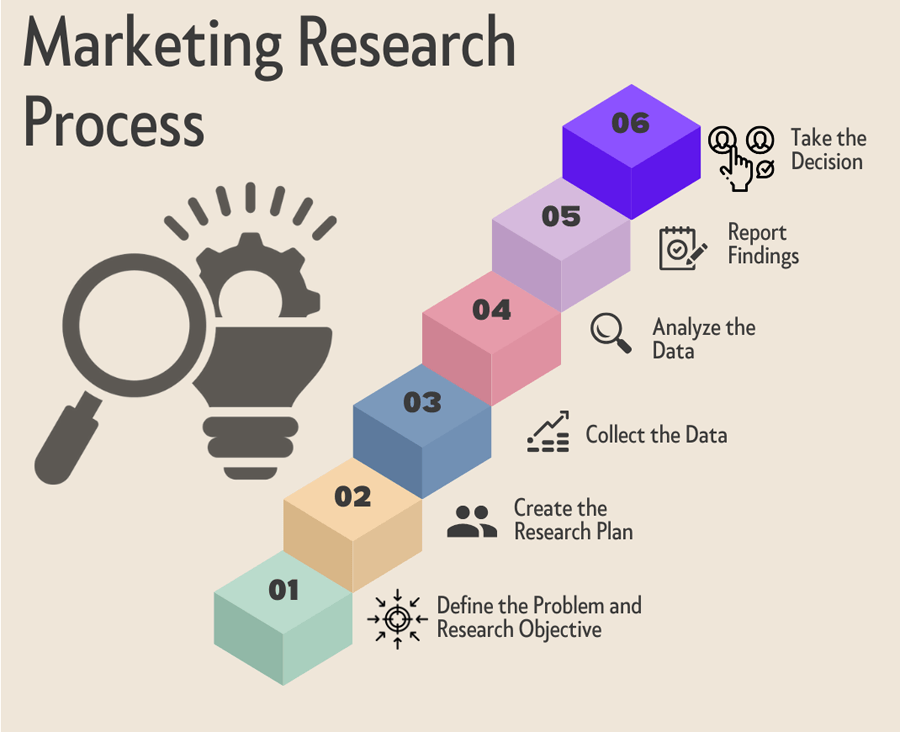Marketing Research

Want to know your customers better? Start with marketing research.
Marketing research is the compass that guides businesses through the ever-changing landscape of consumer preferences and market trends. By diving deep into customers’ minds, companies uncover valuable insights to inform product development, advertising strategies, and customer engagement. Imagine launching a new product without understanding what your audience truly wants – marketing research helps you avoid that gamble, ensuring your efforts resonate with the right people at the right time.
Marketing Research Process
 Effective marketers follow a structured process to maximize the potential of all resources and practices. Here are the six essential steps:
Effective marketers follow a structured process to maximize the potential of all resources and practices. Here are the six essential steps:
Define the Problem and Research Objective
The most crucial step in any marketing research project is determining the problem. Before conducting research or collecting data, you need to understand what you want to learn. Identifying the root problem or opportunity helps determine the necessary information and how to obtain it. For example, you might explore how to address a loss in market share or how to launch a product for a specific demographic.
Create the Research Plan
Marketing managers must decide on data sources, research methods, research instruments, sampling methods, contact methods, and research tools to design an effective research program.
- Data Sources: Researchers can collect secondary data, primary data, or both. Secondary data already exists and was collected for another purpose, while primary data is gathered first-hand for a specific project.
- Research Methods: Five main methods to collect primary data include observation, focus groups, surveys, behavioral data, and experiments.
- Research Instruments: Common instruments include questionnaires, qualitative measures, and technological devices. Questionnaires, with both closed-end and open-ended questions, are particularly flexible and useful.
- Sample Plan: This involves deciding on the sampling unit, sample size, and sampling procedure to ensure the sample is representative and reliable.
- Contact Methods: Respondents can be reached via email, phone, in person, or online.
Collect the Data
Data collection is usually the most costly and error-prone phase. Respondents might be unavailable, uncooperative, or dishonest, requiring follow-up or replacement.
Analyze the Data
Researchers tabulate data and create summary measures. They calculate averages, dispersions, and use advanced statistical techniques to test hypotheses and strengthen conclusions.
Report Findings
Researchers present their findings, often in a consultative role, translating data into insights and recommendations. Clear, persuasive reports are crucial for effective decision-making.
Take the Decision
Based on the research report, top management makes informed marketing decisions. If unsatisfied with the report, they might discard it and start a new research project.
Benefits of Marketing Research
Identify Marketing Opportunities
Marketing research allows companies to identify gaps in the market, understand consumer needs, and adapt products accordingly. This proactive approach helps in tailoring products or services to meet market demands, thereby increasing the chances of success.
Understand Customer Preferences
By continuously tracking consumer behavior, preferences, and feedback, companies can stay attuned to what their customers want. This knowledge enables businesses to create products and services that align with consumer expectations, fostering customer loyalty and satisfaction.
Inform Marketing Strategies
Data-driven insights from marketing research provide a solid foundation for developing marketing strategies. Companies can create targeted campaigns, choose appropriate marketing channels, and allocate budgets more effectively, leading to better outcomes and higher returns on investment.
Reduce Marketing Risk
Conducting thorough research helps companies avoid costly mistakes. By understanding market conditions, competition, and consumer preferences, businesses can make smart decisions about product launches, market entries, and other strategic moves, minimizing the risk of failure.
Calculate Market Size
Accurate assessment of the market size allows businesses to understand the potential demand for their products or services. This helps in setting realistic sales targets, planning production, and ensuring that resources are allocated efficiently.
Support New Product Launches
Marketing research plays a critical role in testing new products on a smaller scale before a full-scale launch. Feedback gathered during this phase can be used to make necessary adjustments, ensuring that the product meets consumer needs and expectations.
Monitor Market Trends
Keeping an eye on industry trends helps businesses stay ahead of the competition. By identifying emerging trends early, companies can innovate and adapt their offerings to meet changing market conditions, gaining a competitive edge.
Measure Company Position
Marketing research provides valuable insights into a company’s market position and reputation. This information helps management understand how their brand is perceived, identify areas for improvement, and develop strategies to enhance their market presence.
Disadvantages of Marketing Research
Cost
Marketing research can be expensive, especially if it involves hiring external agencies or conducting large-scale studies. Costs can include survey design, data collection, analysis, and reporting. For smaller companies with limited budgets, this can be a significant barrier.
Time-Consuming
Conducting comprehensive marketing research takes time. Designing studies, collecting data, analyzing results, and compiling reports can be a lengthy process. In fast-paced markets, this time investment might delay decision-making and implementation.
Inaccurate Information
Poorly designed research can lead to biased or inaccurate results. Issues such as leading questions, unrepresentative samples, or respondent dishonesty can skew data, leading to incorrect conclusions and misguided decisions.
Rapid Market Changes
The dynamic nature of markets means that research findings can quickly become outdated. What is relevant today may not apply tomorrow, making it challenging to rely solely on past data for future decisions.
Biased Results
Human involvement in research introduces the potential for bias. Researchers’ personal values, attitudes, and prejudices can influence the design and interpretation of studies. Additionally, respondents’ socio-cultural factors can affect their answers, leading to subjective results.
Conclusion
Marketing research is essential for businesses to determine product demand, viability, and performance in the real world. By using primary and secondary data, companies gain unique insights that drive their success and growth. Research and development (R&D) are crucial components of this process, ensuring that companies stay competitive and meet market needs effectively.